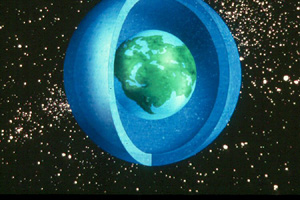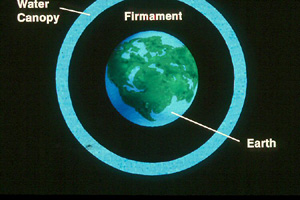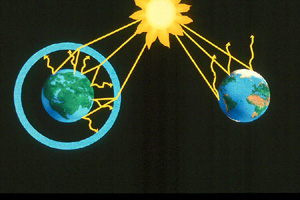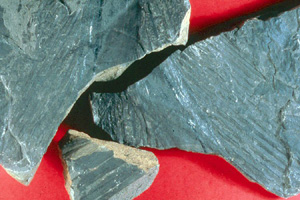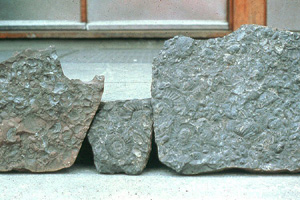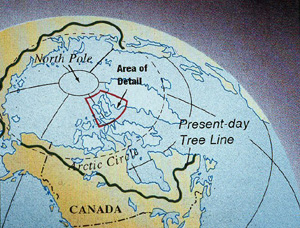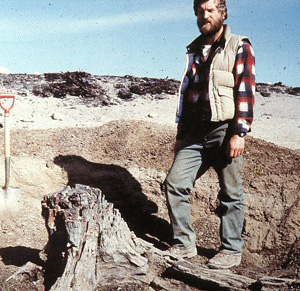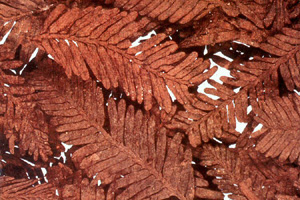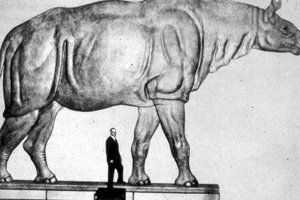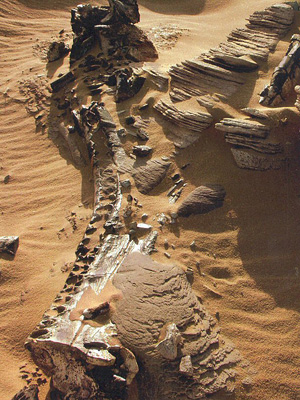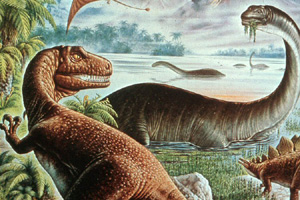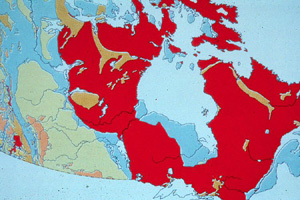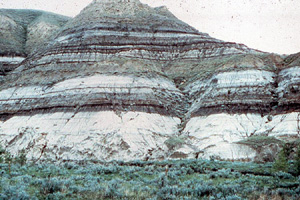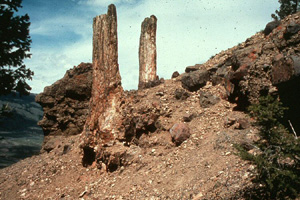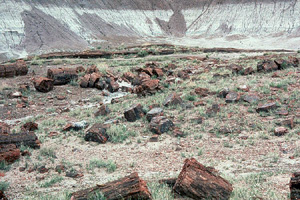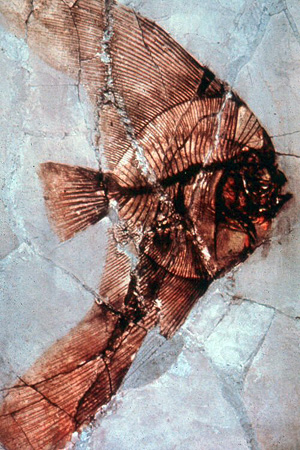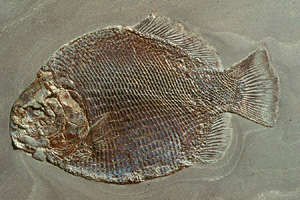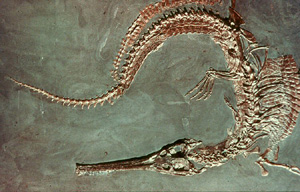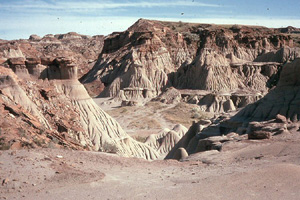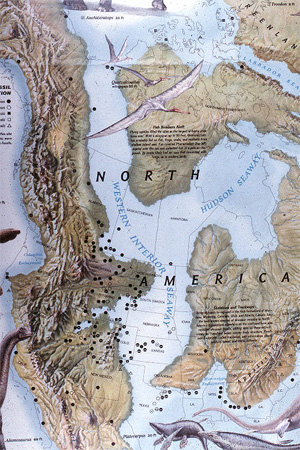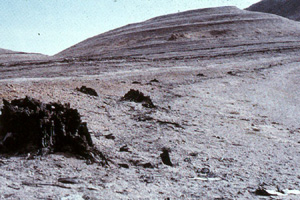Welcome back to our seminar entitled, Searching for Truth on Origins. We are moving on now to session number six. We are going to continue discussing the subject of the history of life, only this time from a biblical perspective.
In the Genesis 1:6-7, the Bible seems to indicate that God created the earth and that the original earth was created in a somewhat different form than what we see today. Beginning with verse 6:
And then God said, "Let there be a firmament in the midst of the waters. And let it divide the waters from the waters." Thus God made the firmament and divided the waters which were under the firmament from the waters which were above the firmament and it was so.
What is the Bible referring to? Well, it is interesting that if we take this verse literally, it would seem that the original earth was created with some form of water surrounding the earth.
What we are looking at here is not a photograph of the original earth, obviously, but it is a graphic artist’s illustration or representation based on what the Scriptures are saying. God created the earth with water above the earth separated from water on the earth.
There are many creationists (including myself) who consider this canopy model in order to try to understand what the earth was like and what happened to the original earth. Obviously, this is based on a certain amount of speculation. This is not a photograph—no one was there in space and took the photograph. But the verses in Genesis 1 describe some form of water above the earth that was separated from water on the earth. We certainly do not know how high the water layer would have been above the earth. We do not know how thick it was. We do not even know in what condition the water may have been. Of course we know that water can be liquid, it can be ice, and it can be in a gaseous form. So this is simply presented to you for consideration as a possible model based on the Scriptures.
It is also interesting to note that the Bible says that the water that was on the earth was gathered together in one place. In Genesis 1:9-10, God said,
Let the waters of the earth be gathered together into one place. Let the dry land appear. And it was so. And God called the dry land earth. And the gathering together of the waters called He seas. And God saw that it was good.
So the original earth, according to the Bible, was one large land mass surrounded by some form of water. Here is another way of looking at this from a cross-section of that same illustration.
The water above the earth is called the water canopy. And between the water layer above and the water on the earth there is a firmament, or space, or atmosphere. And as we have noted here on this illustration, the earth gathered together in one large land mass. Incidentally, that is exactly what geologists tell us the original earth was like—one large land mass. We know that the layers of the earth were laid down on that original land mass. And then some time later in history, the continents separated and broke apart. And we will look at the possibility a little later of when that may have happened from a biblical perspective.
Now if such a condition existed, then the earth and its atmosphere would have been much different than the earth we know today. And the best way of trying to relate to this or to understand what the original earth may have been like, would be to compare our earth to a greenhouse effect. Long wave radiation from the sun passing through the glass panes of a greenhouse produces vigorous growing conditions. We know that we can grow plants in a greenhouse indoors. They grow much more vigorously than outdoors because the long wave radiation is trapped within the greenhouse, producing these vigorous, growing conditions. If the earth was surrounded by some form of water then we would expect the original earth would have been somewhat like a greenhouse. Or another way of describing it, like a giant terrarium. So if this were the case, the climatic conditions would have been consistent from pole to pole, unlike our earth today.
In this illustration on the right-hand side, we see what it is like on Planet Earth in the present day. Energy from the sun reaching the Polar Regions is not as intense as the energy that reaches the equatorial regions. And as a result of this, there is an unequal heating of the earth’s surface. And because of the unequal heating of the earth’s surface, this creates high and low air pressure masses or hot and cold fronts, which of course tend to equalize. And this is what brings about weather conditions.
Recently we have become familiar with what is called the El Nino effect. This is where our planet is heating up in various places, causing changes to all kinds of environmental factors. If the planet heats up equally, the weather conditions upon the surface of the earth would be more consistent. And that is what we would expect based on this biblical canopy model—from pole to pole a temperate climate with no conditions that would bring about storms or severe weather. And it is interesting that from the Genesis account we are told that the original earth, at this particular time, had no rain—only a mist that rose up from the ground.
Finally, one other factor should be considered regarding this model: if there was some form of water, whether it was water vapor or water itself surrounding the planet, it would have protected the earth from harmful shortwave radiation. We know, for example in nuclear power plants, that they take the spent fuel bundles and store them in pools of water because water acts as a good shield against radiation. If the water vapor barrier or a water barrier existed that surrounded the earth, shortwave radiation (ultraviolet radiation which bombards the planet) would have been shielded. And life living on the planet at that time would have been able to live on a protected environment, and live longer. And living longer and growing more vigorously under these conditions, one of the things that we could predict is that life would also grow larger. Now if it has any validity, then certainly we must be able to find some evidence that would support that this has occurred. Remember the things that we predicted: a temperate climate from pole to pole, vigorous growing conditions, and the earth being protected from radiation. This temperate climate would exist all over the planet. Life would grow larger and it would live longer.
Now, speaking of living longer, when we read through the Genesis account where we are given the genealogies of men, one of the first things that we read about in the Scriptures is that human beings (at this particular period of time in history) lived for a long time. In fact, many of the genealogies indicate to us that the people of that day lived seven, eight, or even nine hundred years. It is often at that point, when people read the Bible and they come across the age of man, they say, "How could you trust in a book that says that human beings could live for that period of time?" But remember if the earth was designed differently than it is today—protected as we have described—there is that possibility that life could have lived longer.
And by the way, if Adam and Eve had not sinned, how long would they have lived? Forever! So this is an interesting possibility that the earth was created differently with a protective environment, so that life existed in a temperate climate from pole to pole. Life lived longer and grew more vigorously.
Well, what I would like to do at this point is to look at some evidence from the fossil record that indicates that our original earth was different in the past than it is today. And we will take a trip around the world.
First of all, I want to point out these fossils. They are palm leaf fossils which we found in the northern part of Vancouver Island.
Now today if you go to Vancouver Island you will not find palm trees that grow there in a natural condition. In the past they did. And something has happened to them. What happened to them? Well, they are buried in volcanic material. You can see the imprints of the palm leaves, but they have been covered over in basalt, hot magma. And the impressions have been made so that today we can see that there were palm leaves that were in this location in the past.
We could go much further north in the northern hemisphere to the North Pole. And there are two different groups of islands and they are circled on this map:
The Spitzbergen Islands, which are north of Norway and the New Siberian Islands, which are north of Siberia. And in these locations, the fossil evidence indicates that in the past the climate was much different. For example in the New Siberian Islands, the first person to go to this location and discover the islands, records in the literature that he found fruit trees sixty feet or more in height with fruit and leaves on the branches that were frozen in ice. In the Spitzbergen Islands the remains of palm trees have been discovered. Also there was a temperate climate here because we see marine organisms like coral that only live today in subtropical waters.
Obviously, there was something different in the northern hemisphere in terms of climatic conditions.
Here is another example of what the planet was like in the past, as we point to these two lines on this particular map which are called the Present-day Tree Line.
This indicates that today, north of the tree line, there are no trees.
You see our planet is like a mountain. It has a tree line and at a certain altitude the trees stop growing. There is a tree line in the northern hemisphere where the trees stop growing and there is a tree line in the southern hemisphere. The arrow is pointing to the tree lines in the northern hemisphere. And the island that you see identified on this particular map in the area of detail is only a few hundred miles from the North Pole. It is called the Axel Hyberg Island. A number of years ago in the ‘80s, some geologists were in the area exploring for oil and a helicopter pilot and team of geologists were flying over this area. They looked down and they could not believe what they were seeing. They could see the remains of trees.
They landed the helicopter and that is exactly what was there—Redwood trees.
Here you see one of the geologists has removed some of the material from this tree. And the interesting thing about this is that it is still organic. You can take the wood and you can burn it. Also other kinds of vegetation indicate, in the Canadian Arctic in the past, that the climate was temperate. In fact they say it would have been exactly like the Florida Everglades.
In the Antarctic area as well, there is evidence from the fossil record that the climate was similar.
Now one of the other predictions we proposed is that if the climate was different, due to some kind of a canopy effect in the past, life would have grown larger. Now this is one of the things that we find in the fossil record—it is a mystery. For example moss-like plants today only grow an inch or a fraction of an inch. In the past they grew three feet in height. Today horsetail-reeds grow in marshy areas between two to three feet in height. In the past, they grew 90 to 120 feet in height.
Insects were much larger in the past. For example: cockroaches grew fifteen or more inches long. There were dragonflies with wingspans of over three feet. Ferns of the past were 90 to 120 feet tall. Shells of the past, like Nautiloids, were nine to twelve feet in diameter, compared to their counterparts today which are just a few inches in width. The sloths of the past grew eighteen to twenty feet in height. Today they are about the size of small monkey.
Rhinos of the past were larger. Here is a rhino model in a museum in Nebraska that is based on a fossil that was discovered there.
And as you can see, there is a man standing beneath the rhino, which is eighteen feet or more in height and thirty-two feet in length.
Crocodiles and alligators of tremendous sizes have been found in the fossil record. Like this one.
That is the remains of a crocodile found in the Sahara Desert. By the way, you may be asking the question, why would there be a crocodile in the desert? Well the Sahara Desert has not always been a desert and the fossil remains in this area indicate that at one time in earth’s history this area was very lush and subtropical. But something has occurred to bring about the change in the climatic conditions. The remains of this crocodile were discovered in the Sahara which rivals the size of some of the dinosaurs with which it would have cohabited.
Speaking of dinosaurs, here is another mystery of the fossil record. We find dinosaur fossils all over the planet, from the North Pole to the South Pole. And they are buried in the layers of the earth. Another mystery about dinosaurs is their size. They grew to tremendous sizes. Not all of them, but we find that many grew to huge sizes. And another thing that we know about dinosaurs is that they lived at a time when the planet was different climatically.
So here in this particular illustration, we see large dinosaurs.
You will notice the presence of palm trees in the background and behind that you will see something else—it is a volcano. What happened to the dinosaurs? That is the typical question that most people have asked. But perhaps a better question would be, what happened to life?
In our creation model, we read from the Scriptures that God created life and it was good. And we also mentioned that the Scriptures say that life was created and as a result of sin, it was later destroyed in a great worldwide catastrophic event.
What I would like to suggest for your consideration, is the possibility that not only were dinosaurs destroyed, but all life was destroyed together at the same time. And that original climate (temperate from pole to pole) in which all life lived together, came to an end in a single event. The Bible describes the great flood of Noah in the book of Genesis. Let’s turn again to the Scriptures, this time to Genesis 7:11-12.
In the six hundredth year of Noah’s life, in the second month, the seventeenth day of the month, the same day were all the fountains of the great deep broken up. And the windows of heaven were opened and the rain was upon the earth for forty days and forty nights.
Here we find in Genesis, I believe, one of the most significant events in earth’s history. What happened? Well, simply this—God had created Adam and Eve. They were created with a free will to choose whether or not they would remain obedient. And they chose not to obey. We are told that there was the Fall and the curse upon the creation. And as we read through Genesis 6, we see what occurred. The wickedness and the perversion of man became so great, that God was grieved He had created. And so, the Bible tells us that God warned that He was going to bring a destruction. The thoughts of men’s hearts had become evil continually. And so, God warned that He was going to bring the great destruction upon Planet Earth. And we read through the account that Noah and his family and a remnant of each kind of life were preserved. And then the great flood came as we have read here in these two verses. There was a major, worldwide event which involved the destruction of life. The fountains of the great deep broke up, the windows of heaven were opened, and it rained for forty days.
So what occurred? Well, I think we can understand if we take what the Scriptures say, literally. With reference to the fountains of the great deep, the Bible is referring to the fracture in the earth’s crust. When the earth’s crust fractures, out of the earth comes magma, hot molten rock, and volcanic ash. And because this was a worldwide event, it was happening all over the planet—on the land and underneath the oceans—there was a tremendous geological catastrophe.
Secondly and simultaneously, the Bible says the windows of heaven were opened. What is that referring to? It is referring to materials being poured down upon the earth from above. We know that in the past, this earth has been struck by objects from the heavens. There could be various sources like asteroids and perhaps comets. Whatever it was, materials were falling upon the earth, which was part of this great catastrophe. Some of these great bodies fell in the oceans and some on land.
Thirdly and simultaneously, the Bible says that it rained. It was the first time that it had rained, and so water came down from above. Certainly it would only be a minute source of the floodwaters, for we know that this planet itself is covered by two-thirds with water. So it would be only a matter of a slight sinking of land masses and a raising of the ocean beds, and the entire surface of the planet could be covered. And that is exactly what happened—tremendous volumes of water covered the earth.
In Psalm 104:5-9, we are given some insight into what occurred at the time of this great flood.
Who laid the foundations of the earth that it should not be removed forever. Thou coverest the deep as with a garment. The waters stood above the mountains. At Thy rebuke, they fled. At the voice of Thy thunder they hastened away. They go up by the mountains, they go down by the valleys into a place which Thou hast founded for them. Thou hast set a bound that they might not pass over, that they turn not again to cover the earth.
The Bible seems to be describing a time when the oceans covered the land. That is what the Bible tells us in the Book of Genesis—hundreds of cubic miles of water were displaced.
From the oceans covering the land, in Genesis 7:17-21 we read:
Now the flood was on the earth forty days. The waters increased and lifted up the ark and it rose again above the earth. The waters prevailed and greatly increased on the earth. And the ark moved about on the surface of the waters. And the waters prevailed exceedingly on the earth. And all the high hills under the whole heaven were covered. The waters prevailed fifteen cubits upward and the mountains were covered. And all flesh died that moved on the earth: birds and cattle and beasts and every creeping thing that creeps on the earth and every man.
You see it is important to consider what the Bible has to say. And when it comes to this subject of a flood, you will notice it says all flesh died that moved on the earth. This is a worldwide flood, not a local flood, like some creationists who try to interpret the Bible from an evolutionary geological perspective. The Scriptures are clear. When God warned that He was going to bring a judgment, it was to destroy all flesh. The only survivors were those that He supernaturally preserved with Noah aboard the ark. It was a worldwide event.
We continue in verses 22 to 24:
And in whose nostrils was the breath of the spirit of life—all that was on the dry land died. So He destroyed all living things which were on the face of the ground. Both man and cattle, creeping things and birds of the air, they were destroyed from the earth. Only Noah and those who were with him in the ark remained alive, and the waters prevailed on the earth one hundred and fifty days.
So according to Scripture, this earth was destroyed in a worldwide catastrophic event. The oceans covered the land. The waters moved from place to place. Tremendous waves swept over the land masses. And with these waves materials were carried—mud, and ash, and life forms that were buried. They were buried in the layers of the earth.
At the end of the great flood, the waters upon the land drained back to the oceans, causing tremendous erosional forces and the formation of canyons. At the end of this flood, we would expect to see the deposition, wherein layer after layer was deposited horizontally. And in these layers we would expect the remains of life that had been buried under conditions that have never been repeated. You see that is the flood model.
It is interesting that today most geologists consider what the Bible has to say about a worldwide flood as nothing more than myth. It is a fact when studying ancient history and the records left by the ancients from civilizations of the past, that there are over a hundred and fifty accounts from various countries that this earth was destroyed in a worldwide flood with few survivors. The Bible tells us that it happened and the evidence tells us that it happened.
You see, if this flood model is a myth, then we should not even waste our time considering it. But if it is true, then what God has said in His Word we should be able to substantiate and find evidence of in His world. And so, that is what I want to do now over these next few minutes. We want to observe evidence around the world that this planet in the past experienced a great worldwide destruction.
First of all, we are looking at this geophysical map of Canada.
This large red area that you see is the Canadian Shield. And in the middle of the Canadian Shield you will see a large bay, which is called the Hudson Bay. Do you know that scientists have begun to recognize that the Hudson Bay was formed when some object slammed into the earth from above, perhaps an asteroid or a comet? And that magma from within the earth has come out upon the surface of the earth. Could you imagine the scale of that kind of catastrophe?
We go to western Canada. This is in Alberta, near Drumheller, at a location where I have gone many times to look for the remains of dinosaurs and other fossils.
And there in the Red Deer Valley, we see layers of volcanic ash, mud, and coal in the wall. And these layers go down thousands of feet into the surface of the earth. And it is in these layers that they find all kinds of fossils: fish, clams, palm trees, and dinosaurs. Some of the dinosaurs are buried in swimming positions.
We go now to the northern United States to Yellowstone National Park and on the peaks of the mountains there, we see these huge redwood trees.
You will notice the surrounding material—that is volcanic breccia. Some of it has been eroded. Those trees at one time were buried in volcanic materials that have since been eroded away. And so now we can see the tree stumps. They have been turned from wood to stone, fossilized under these kinds of catastrophic conditions.
Now we could go to Arizona.
This is called the Petrified Forest, although few people believe that trees actually grew there. Well there are some tremendous trees here—redwoods that are 250 feet or more in height. You can see some of the broken tree stumps. There is one tree there in the foreground that is over 200 feet in length. And notice in the background what we observe. Those hills there are made of volcanic ash and mud that has been deposited by water. You see, perhaps a better name for the Petrified Forest would be the petrified log jam because that is exactly what happened. These trees did not grow in this location. These trees were buried in a great flood—a catastrophic event involving volcanic activity. And perhaps we can be reminded about what took place at Mount St. Helens in 1980, when the trees were stripped off the slopes of the mountains and then great log jams were created. You see at one time in earth’s history this happened all over the planet.
Speaking of the planet, we could take a trip all over, on every continent and we would find example after example that clearly reveals that in the past something occurred that brought about a sudden destruction of life.
Fish in Scotland have been found with their fins extended and their eyes bulging. They have been caught and buried in a moment of time.
In Germany there are fish buried in oily bituminous, which is oily clay mud. Again, they were quickly caught and preserved.
Throughout North America there are fossil beds in various places. On every continent, whether it be in Australia, in China, or throughout the former Soviet Union, we find these examples of life forms.
And as I am showing you, some of them are obviously in swimming positions. They have been suddenly trapped and buried, in a moment of time.
In Nebraska, there are rhinos caught in volcanic materials—caught and buried, suddenly. And there is a tree in Tennessee which is called a polystrate fossil. That means that it goes through more than one layer. There is a coal scene, representing supposedly hundreds of millions of years of deposition. And there is a sandstone layer, representing supposedly millions of years. How could a tree stand there over these millions of years and gradually be buried? Is there another explanation? Is it possible that this tree was buried as a result of some major catastrophic event and those layers were laid down quickly at the same time?
Here is a dinosaur fossil.
This one was found near Drumheller and on part of the outside of the bone you can see a layer of ironstone. Initially that material was completely surrounding the bone, before the picture was taken and it broke away. It is interesting that in southern Alberta, entire dinosaurs have been caught buried in this ironstone material. In one place, near Huxley, an entire dinosaur was buried in 200,000 tons of this ironstone and the footprints and the skin imprints were still there. Clearly this was not a gradual event. Some major catastrophic event has had to have occurred.
This location is near Brooks, in southern Alberta.
I had taken a film crew to this location in the late ‘80s to do a film documentary. We went to this region because over 350 dinosaurs had been removed from this particular area. And so we were asking the park geologist why so many dinosaurs were found here? He said he believed it was because a long time ago—65 million years ago—that is when they believe that dinosaurs became extinct. And there was a river that was flowing through this region and it was during a flood season when the river was running very high and very quickly. He said there was a herd of dinosaurs that attempted to cross the river. The first one got part way across, tripped and drowned. He said that the second one was following too closely to the first and he tripped over him and drowned. The third over the first two and the fourth over the first three and so on, until all 350 dinosaurs tripped over each other and drowned in this region and they were buried in a local flood.
But this same response regarding the burial of dinosaurs is quite common in other places. The same is true in Montana. They say there was a local flood and the same in Utah. I have had the opportunity to be in Argentina, South America where they have found many, many dinosaurs. They say that there was a local flood in Argentina.
Several years ago I was in Beijing, and I met with scientists who were doing research on dinosaurs in Mongolia. I asked them what they believed happened to the dinosaurs there. They said there was a flood in Mongolia. And the same thing happened in Russia.
It is interesting that geologists are willing to acknowledge that dinosaurs were buried in various places by local floods, but they will not acknowledge that perhaps that flood may have been global—everywhere at the same time.
You are looking at a map of North America where you see much of North America covered by a large body of water from the Arctic down through Alberta, Saskatchewan into central United States.
And you will notice that along the shores of this body of water there are dots. These are locations where they have discovered remains of dinosaurs. And so the theory is that in the past, dinosaurs lived at a time when the climate was different—when the oceans covered the land and they died out.
You will see some depictions of dinosaurs sinking in quicksand, or some that have died alongside streams and they are gradually being buried. You see that is the typical explanation of what happened to dinosaurs.
Of course there are other theories, but the most recent theory I find very interesting. Louis Alvarez and others have come to the conclusion that dinosaurs were wiped out in a great catastrophe. They believe that not only dinosaurs but other kinds of life, in fact all of the fossils that we see represented, may have been wiped out and destroyed in the past by some event which involved objects falling from the heavens upon the earth and the earth’s crust fracturing. And as a result of the earth’s crust fracturing, volcanic activity caused magma to be poured out on the surface of the earth, volcanic ash. And it is also believed that some of these objects may well have slammed into the oceans, creating waves four miles high, sweeping over the land and destroying life. This describes an ancient cataclysmic event.
That is exactly what the Bible says happened. But you see they say it happened 65 million years ago. The Bible says that it happened in rather recent historical times. God said that He would bring destruction and He did. The evidence is overwhelming but the amazing thing is that these scientists who believe in evolution do not want to consider the possibility that there was a worldwide flood.
Here is the region in the Axel Hyberg Island that I previously showed you, where those redwood trees were found.
And this is exactly what it looked like when the geologists first landed in the helicopter. There were tree stumps sticking out of the ground and you could take the wood and burn it. I met with one of the geologists from the University of Saskatchewan, Dr. Bassenger. And I asked him, "How could redwood trees have grown in this part of the world in the past? Today this area is covered in ice and snow most of the year and virtually nothing grows there during the summer months." He said, "We do not know. It is a mystery. The climate was different." But he said, "One thing we know, it appears that this area was involved in a number of floods." I said, "How do you know that?" He said, "Well, notice these hills in the background of this picture. You see those layers? Well each one of those layers was formulated by a flood. And these floods took place over hundreds of thousands of years, so the area has been devastated many times." And I said to him, "What if the layers were formed by the same flood at the same time?" He said, "That sounds biblical and that would be impossible." You see, some have chosen not to consider what the Bible has to say.
At this very time, there are scientists who are making observations on Mars. And what they say they have found on Mars is evidence of a major planet-wide flood. They find huge canyons that they say have been formed as a result of erosion. And in the walls of the canyons they say they can see strata and layers which clearly show that they have been formed as a result of water. They say that on Mars there was a planet-wide flood. But I ask you this question: how much water is there on Mars? Well, some people say, some water but very little.
And here on earth, we have tremendous amounts of water. Two-thirds of this planet is covered by water. The Bible says that at one time the water came over the land and it destroyed this earth. And yet these same geologists who are evolutionists refused to acknowledge that this has happened.
In Job 12:7-11 are some very important verses. This is what it states:
But ask now the beasts and they will teach thee. And the fowls of the air and they shall tell thee. Or speak to the earth and it shall teach thee. And the fishes of the sea shall declare unto thee. Who knoweth not in all these that the hand of the Lord hath wrought this? In whose hand is the soul of every living thing? And the breath of all mankind; Doth not the ear try words and the mouth taste his meat. Ask now the beasts and they shall teach thee. And the fowls of the air and they shall tell thee.
See the Bible challenges us to do something. Go out and make observation of things that are living. Or as it says, check out the earth and what will it tell you? Very clearly it will tell us this: if we make the observations and are not biased in our opinions, what we will observe is that this earth has been destroyed. Life that was created is found buried in the earth. There is ample evidence of this. And so, when we see layers and we see fossils, how can they be interpreted? It can be interpreted two ways: This planet is billions of years old and the layers have been formed gradually and life lived and died. Or, this planet has been destroyed as a result of a worldwide catastrophic event. God warned that He would bring a judgment and He did. The layers are there. And in the layers are the life forms that have been preserved. Why? To show us when God says that He has done something, we can believe it.
This planet has been destroyed through a judgment by God. In 2 Peter 3:5-6 it says,
For this they willingly are ignorant of, that by the word of God the heavens were of old, and the earth standing out of water and in the water whereby the world that then was, being overflowed with water, perished.
The evidence is overwhelming! In Job it says that just as your mouth can taste food and what is good and what is not, so too when information is inputted to you—to your mind through what you see and what you hear—your mind is capable of determining what is right. Was there a worldwide flood? The Bible says there was.
And now this Scripture also from Peter is concluding more on a positive note:
Nevertheless, we, according to His promise look for new heavens and a new earth wherein dwelleth righteousness. Wherefore beloved, see that ye look for such things. Be diligent that you may be found of Him in peace without spot and blameless. (2 Peter 3:13-14)
Remember what Peter said? "God is not willing that any should perish, but that all should come to repentance" (2 Peter 3:9). You see, God who judged and destroyed the world has also provided a way for salvation. Just as Noah and his family and a remnant of each kind of life was preserved at the time of the great flood, God has provided a way for each one of us to know Him and spend time with Him for eternity. For the Bible says the Creator of the universe loved us so much that He Himself came to this earth and He lived a perfect life in our place. We could not do it, but He did. His life was sacrificed upon the cross. His blood was shed so that whosoever would believe in the Creator (who He is and what He has done) and whosoever would acknowledge themselves as sinners and ask for forgiveness, they could enter into a relationship with the Creator.
Why am I a creationist? I have come to discover that there is a Creator, there has been a creation and the Creator loves me. It has made a tremendous difference in my life. I trust that this presentation will help build up your faith. And for those who may be here or may be watching or listening later, consider the claims of Scripture. There is a Creator. There has been a creation. It is the truth.
Thank you for reviewing this lecture brought to you by Blue Letter Bible. The Lord has provided the resources, so that these materials may be used free of charge. However, the materials are subject to copyrights by the author and Blue Letter Bible. Please, do not alter, sell, or distribute this material in any way without our express permission or the permission of the author.
We invite you to visit our website at www.BlueLetterBible.org. Our site provides evangelical teaching and study tools for use in the home or the church. Our curriculum includes: classes for new believers, lay education courses, and Bible-college level content. The lectures are taught from a range of evangelical traditions.
For any questions or comments please feel free Contact Us.


